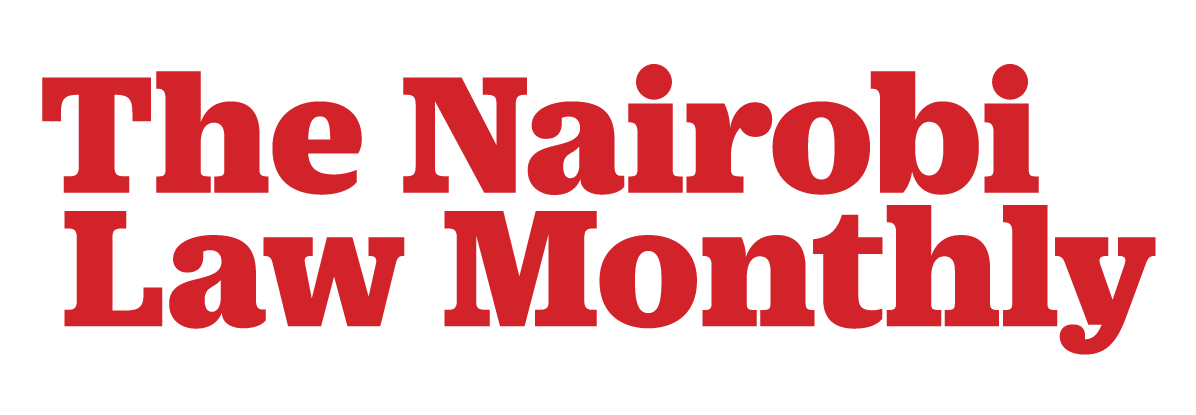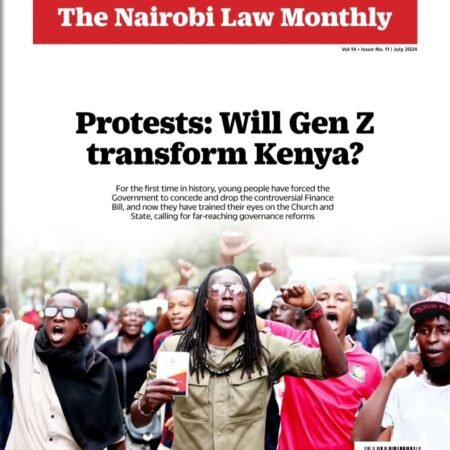Dr Charles Khamala
Corruption is a multi-faceted phenomenon. Its subject matter is wide, varied and elusive in scope. Further, because “corruption research is a taboo – a corrupt process in itself,” Keith Rosenn (1971) explains, this is why it has, until recently, been shunned. Therefore, diverse disciplines improvise different definitions to delimit the relevant bribery data.
-
Sale!
Download Nairobi Law Monthly Magazine July 2024 Edition
Downloads Original price was: KShs200.00.KShs100.00Current price is: KShs100.00.
At its simplest, for Rick Stapenhurst and Shahrzah Sedigh (1999), corruption is “the abuse of power, most often for personal gain or for benefit of a group to which one owes allegiance.” Moreover, “no country is today immune from corruption’s corrosive influence.” Syed Alatas (1990) warns that “failure to make the distinction between different types of corruption and to place them into their proper evaluative context… leads to confusion and time wasting.” He proceeds to divide corruption into “transactive, extortive, intensive, defensive, nepotistic, autogenic and supportive” categories. He believes that such classification overcomes defeatism, which breeds lethargy, thus condoning the vice.
On December 9, 2003, in Merida, Mexico, Kenya became the world’s first country to sign and ratify the UN Convention Against Corruption. That Convention was adopted by the UN that October, even after Kenya’s Anti-Corruption and Economic Crimes Act, No. 3 of 2003, had established an Anti-Corruption Commission, the predecessor to the Ethics and Anti-Corruption Commission (2011), as well as a Public Officer Ethics Act, No. 4 of 2003.
These statutes were followed by a Public Procurement and Disposal Act (2005), all culminating into Chapter 6 of the 2010 Constitution enshrining “leadership and integrity” into national values.
This year, a new Public Procurement and Asset Disposal Act, No. 33 of 2015 came into force. Despite this slew of legislation, corruption persists. Worse still, no significant conviction has been achieved to vindicate the Jubilee government’s seriousness in its war against corruption. Instead, the Cabinet proposes to enact yet another Anti-Bribery Bill to re-orient its approach in dealing with the vice. It seeks to redefine who to punish and reward. Can legal re-definitions or criminalisation, of bribers rather than ‘bribees’, aid in tackling corruption? This article adapts concepts from economic poverty to construct fine distinctions between three terms: descriptive, prescriptive and relative corruption. It aims to critically analyse Kenya’s new Anti-Bribery Bill.
Comparative “kitu kidogo”
The problem with bending rules to suit expediency occurs in all countries, by government officials and private citizens, alike. Consider Brazil: There, the “jeito” is a paralegal institution, which perfects this art of exploiting the gap between law-in-books and law-in-practice. Or consider that traditional religious institutions have not fomented demands for radical change, but for adherence to rigid dogmas, moral intolerance, great formalism and slowness to social change. Consequently, notwithstanding their formal commitment, whether to Christianity, Islam or Hinduism, many Kenyans, of either gender, maintain “mpango wa kando” or customary spouses. The hypocrisy of cultural and religious relativity is rampant.
Jean Jacques Rousseau in “Du Contrat Social” (1762) asserts, “The sovereign [the people united] knows only the body of the nation and does not distinguish any of those who compose it. Yet, President Uhuru Kenyatta’s March 2016, State-of-the-Nation address avoided this aspect of personal corruption, which silence implicitly implores tolerance or non-accountability by Kenyans. Given that he and his Deputy assumed office under the International Criminal Court’s cloud of pending serious prosecutions, many public officials seem to have inferred a nihilist licence to misappropriate public resources. With the ICC’s ghost having been exorcised, the legitimate question that emerges is, how much public corruption is tolerable before it becomes toxic to and destroys a particular national moral fabric?
In 2015, Kenyatta “renewed our commitment to standing against corruption – an action that led to a robust national debate, renewed scrutiny of public officers and strengthened institutional tools against corruption.” Since last year, he points to “more than 360 corruption cases before the courts, most of them involving senior public officials.” Furthermore he “took the unprecedented step of dismissing a third of (his) Cabinet: a painful but necessary decision.” The Jubilee administration endeavours have spent Sh1.6 billion since last year, on strengthening “information sharing” between Inspector-General of Police Joseph Boinett’s “operational aspects”, EACC’s investigators and Director of Public Prosecutions, Keriako Tobiko. Yet, the criminal justice chain remains glaringly, coincidentally, unsuccessful regarding securing major corruption convictions. Not only are no tangible prosecutions available, by way of meting-out penal sentences, but also worse, some senior suspects continue to gleefully masquerade behind multi-national corporate veils, which shield them from prosecution, courtesy of gaping legislative loopholes.
If the President has lit the fuse on grand theft of public funds, then its gunpowder is the trail of corruption covering-up the tracks of politicians who intend to extinguish voter’s anger from exploding in the ballot kegs. An impending protest vote at the 2017 elections might be averted, if these bribers, alternatively, account for governmental misappropriations before then. An assessment of political clientage, Rosenn argues, thus requires a cost-benefit analysis of corruption. Corruption increases costs, and results in resource misallocation, since for example, procurement or construction contracts are more expensive, through either total inflated price or inferior quality received.
Moreover, social injustice and unrest stems not only from the mere lack of the “appearance” of impartiality, as Lord Devlin (1979) contends, but also, in Gunner Myrdal’s (1968) view, from actually, selectively permitting rogue firms and shrewd individuals to avoid compliance with the law though payment of bribes and family connections. However, the limits of democracy, as John Stuart Mill (1859) notes, is that without decent wages and universal reading, no government of public opinion is possible. Unfortunately, when Kenya embraced multipartysm, masses of people acquired equal procedural opportunities without enjoying the conditions necessary to exploit them. Thus, Karl Marx (1844) posed the question of whether citizens can be politically equal, if they are socially unequal. In Latin America, Adam Przeworski (2009) explains that because “political aristocracy is as much a danger as social aristocracy”, therefore, the government’s power to redistribute income, stimulate desirable conduct, or discourage undesirable misconduct through taxation or regulatory legislation, is sharply limited by corrupt practices.
Development ought to imply meaningful equality before the law. Carl Schmitt (1928) argues “political equality is equality in the eyes of a third party, the state not in the direct relation between any two persons.” On one hand, in a modern society, Rosenn asserts, “conditions precedent to equality are a formal legal structure reasonably attuned to the time and culture – obedience to rule of law, and impersonal, efficient administration of law.” But on the other hand, in a society undergoing rapid transition on the road to development, he concludes, there would appear to be room aplenty for the operation of an institution like the Brazilian “jeito.”
In an intriguing analysis of the Chinese practice of “guanxi” and how it relates to business, Chengze Fan and Herschel Grossman (2001) concur “that corruption serves the economic function of a compensation and incentive scheme with efficient cadres permitted to engage in corruption and inefficient ones controlled through the culture of their criminality.”
Judging from numerous alleged scandals such as the con-of-the-year Safaricomgate, public corruptees are not the only targets for corrupters. A gullible public is vulnerable to private schemers who defraud as much as government officials. Ironically, law makes people free. Hans Kelsen (1929) “teaches us that if we want to remain equal in reality, it is necessary…that we let ourselves be commanded.”
The question becomes, what kind of commander-in-chief should we submit to?
Does ethnicity exacerbate corruption in the African context? Anthropologically, kin-based groups structured the organisation of African society. Ethnic groups refer to particular forms of political organisations that base their collective identity upon kinship relations.
“Ethnic chauvinism,” Edward Oyugi (2016) explains, “is a historical phenomenon, that arises in concrete historical situations in a hegemonic social environment.” Thus, “ethnic identity-political conflicts in colonial and post-colonial history of Africa,” is actually an intellectual exercise in politics and myth-creation. It is the politicisation of culture, under which banner people seek to defend and promote their culture, in opposition to others.
Jeremy Waldron (1999) terms such fundamentalism “cultural vanity.” Corruption is thus far from exclusive to Africa. Kenya’s comparative disadvantage seems to arise from condoning it by taking no retributive action. Praising conspicuous consumption by people with dubiously acquired assets encourages impunity.
Communicative concept of corruption
The term corruption comes from “rumpere,” the Latin verb “to break.” Jeremy Bentham (1797) recognises that although the term “corruption” first applied to decay of vegetable or animal matter, it was subsequently extended to refer to the decomposition, deterioration or degeneration of the mind. The thing broken might be a moral or social rule or administrative code. Richard Posner’s (1973) Law and Economics school views crime as bypassing the market, which avoidance of transaction costs should attract proportionate sanction. Hence to the extent that poverty contributes to inability to pay market prices, it necessarily increases crime.
According to one Economics Nobel Laureate, Amartya Sen (1997), “the sensitivity of the poverty standard to the pattern of distribution relates inter alia to taking a relative view of poverty.” Michael Levi (2002) notes that fencing of illegal acquisitions requires marketing, which can therefore be detected by police. The bribe thus serves as a secondary device by which to purchase police toleration of primary theft. Unfortunately, the poor can spend less on sophisticated, silent communications and, therefore, their re-sales are easier to detect.
Sen instead poses another question of practical importance to both the poverty line and to the bribery index. Is the choice to be viewed primarily as a descriptive exercise? For example, what is the level of income below which a person would be regarded as “poor” and seriously deprived in a given society?
Alternatively, the poverty-cum-bribery index may serve mainly as a “prescriptive” exercise. For instance, what is the level of income below which no one should be allowed to fall in that society? Another Economics Nobel Laureate, Kenneth Arrow (1973), notes thus: “The many significant variations among persons in their capacities – moral, intellectual and physical – and in their determinations of the conception of the good, as well as in their preferences and tastes. The point is that these variations are sometimes so great it is hardly fair to secure everyone the same index of primary goods to cover their needs as citizens and let matters go at that.”

In the global information era, global information activists such as Julian Assange and Edward Snowden, or even local bloggers, like Robert Alai and Wahome Thuku, demonstrate the potential inconvenience that Internet imposes on opaque governance. “What has changed,” regarding the modern delivery of judicial services in the global economy, Stapenhurst and Sedigh argue, “is that information about corrupt practices has become more available as governments have become increasingly unable to conceal evidence of wrongdoing, the level of public tolerance for corruption has declined; and the spread of democracy seems to afford less fertile ground in which corruption can flourish.”…
…To continue reading this story, please buy a copy of the magazine available in all leading supermarkets and street vendors at only kshs 350


